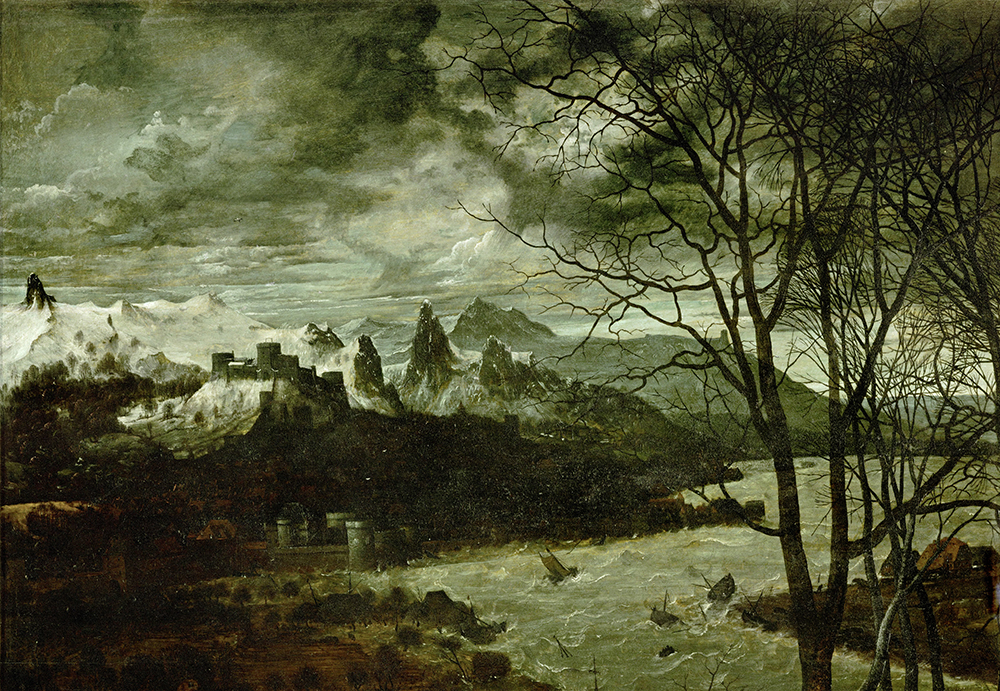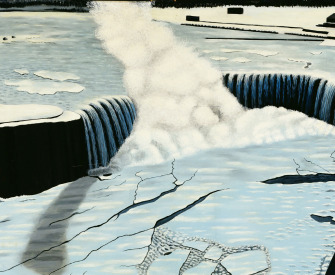Before the earth could become an industrial garbage can, it had first to become a research laboratory.
—Theodore Roszak, 1972Stump Speech
Susan Fenimore Cooper speaks for the trees.
Just at the point where the village street becomes a road and turns to climb the hillside, there stands a group of pines, a remnant of the old forest.
There are many trees like these among the woods, far and near such may be seen rising from the hills, now tossing their arms in the stormy winds, now drawn in still and dark relief against the glowing evening sky. Their gaunt, upright forms standing about the hilltops, and the ragged gray stumps of those which have fallen, dotting the smooth fields, make up the sterner touches in a scene whose general aspect is smiling. But although these old trees are common upon the wooded heights, yet the group on the skirts of the village stands alone among the fields of the valley; their nearer brethren have all been swept away, and these are left in isolated company, differing in character from all about them, a monument of the past.
It is upon a narrow belt of land, a highway and a cornfield on one side, a brook and an orchard on the other, that these trees are rooted; a strip of woodland connected with the forest on the hills above, and suddenly cut off where it approaches the first buildings of the village. There they stand, silent spectators of the wonderful changes that have come over the valley. Hundreds of winters have passed since the cones which contained the seed of that grove fell from the parent tree; centuries have elapsed since their heads emerged from the topmost wave of the sea of verdure to meet the sunshine, and yet it is but yesterday that their shadows first fell, in full length, upon the sod at their feet.
Sixty years since, those trees belonged to a wilderness; the bear, the wolf, and the panther brushed their trunks, the ungainly moose and the agile deer browsed at their feet; the savage hunter crept stealthily about their roots, and painted braves passed noiselessly on the warpath beneath their shade. How many successive generations of the red man have trod the soil they overshadowed and then sat down in their narrow graves—how many herds of wild creatures have chased each other through that wood and left their bones to bleach among the fern and moss, there is no human voice can tell. We only know that the summer winds, when they filled the canvas of Columbus and Cabot three hundred years ago, came sweeping over these forest pines, murmuring then as we hear them murmur today.

The Gloomy Day (detail), by Pieter Bruegel the Elder, 1565. © Erich Lessing / Art Resource, NY.
At length, nearly three long centuries after the Genoese had crossed the ocean, the white man came to plant a home on this spot, and it was then the great change began; the ax and the saw, the forge and the wheel, were busy from dawn to dusk, cows and swine fed in thickets whence the wild beasts had fled, while the ox and the horse drew away in chains the fallen trunks of the forest. The tenants of the wilderness shrank deeper within its bounds with every changing moon; the wild creatures fled away within the receding shades of the forest, and the red man followed on their track; his day of power was gone, his hour of pitiless revenge had passed, and the last echoes of the war whoop were dying away forever among these hills, when the palefaces laid their hearthstones by the lakeshore. The red man, who for thousands of years had been lord of the land, no longer treads the soil; he exists here only in uncertain memories, and in forgotten graves.
Such has been the change of the last half century. Those who from childhood have known the cheerful dwellings of the village, the broad and fertile farms, the well-beaten roads, such as they are today, can hardly credit that this has all been done so recently by a band of men, some of whom, white-headed and leaning on their staves, are still among us. Yet such is the simple truth. This village lies just on the borders of the tract of country which was opened and peopled immediately after the revolution; it was among the earliest of those little colonies from the seaboard which struck into the wilderness at that favorable moment, and whose rapid growth and progress in civilization have become a byword. Other places, indeed, have far surpassed this quiet borough; Rochester, Buffalo, and others of a later date have become great cities, while this remains a rural village; still, whenever we pause to recall what has been done in this secluded valley during the lifetime of one generation, we must needs be struck with new astonishment. And throughout every act of the work, those old pines were there. Unchanged themselves, they stand surrounded by objects over all of which a great change has passed. The open valley, the half-shorn hills, the paths, the flocks, the buildings, the woods in their second growth, even the waters in the different images they reflect on their bosom, the very race of men who come and go, all are different from what they were; and those calm old trees seem to heave the sigh of companionless age, as their coned heads rock slowly in the winds.
The preservation of those old pines must depend entirely upon the will of their owner; they are private property; we have no right to ask that they may be spared, but it is impossible to behold their hoary trunks and crested heads without feeling a hope that they may long continue unscathed, to look down upon the village which has sprung up at their feet. They are certainly one of the most striking objects in the county, and we owe a debt of gratitude to the hand which has so long preserved them, one of the honors of our neighborhood. It needs but a few short minutes to bring one of these trees to the ground; the rudest boor passing along the highway may easily do the deed; but how many years must pass ere its equal stand on the same spot! Let us pause to count the days, the months, the years; let us number the generations that must come and go, the centuries that must roll onward, ere the seed sown from this year’s cones shall produce a wood like that before us. The stout arm so ready to raise the ax today must grow weak with age, it must drop into the grave; its bone and sinew must crumble into dust long before another tree, tall and great as those, shall have grown from the cone in our hand. Nay, more, all the united strength of sinew added to all the powers of mind and all the force of will of millions of men can do no more toward the work than the poor ability of a single arm; these are of the deeds which time alone can perform. But allowing even that hundreds of years hence other trees were at length to succeed these with the same dignity of height and age, no other younger wood can ever claim the same connection as this, with a state of things now passed away forever; they cannot have that wild, stern character of the aged forest pines. This little town itself must fall to decay and ruin; its streets must become choked with bushes and brambles; the farms of the valley must be anew buried within the shades of a wilderness; the wild deer and the wolf and the bear must return from beyond the great lakes; the bones of the savage men buried under our feet must arise and move again in the chase ere trees like those, with the spirit of the forest in every line, can stand on the same ground in wild dignity of form like those old pines now looking down upon our homes.

Susan Fenimore Cooper
From Rural Hours. Born in 1813, the naturalist and daughter of novelist James Fenimore Cooper wrote extensively about rural life in upstate New York. In an 1862 letter to botanist Asa Gray, Charles Darwin wrote that he was enjoying one of Cooper’s books. “Who is she?” Darwin inquired. “She seems a very clever woman.” Considered the first major work of American environmental literature written by a woman, Rural Hours was published in 1850 under the pseudonym “A Lady.”


